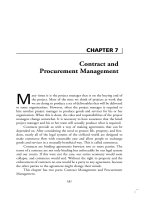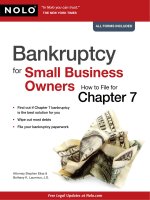Chapter 7 segmentation targeting positioning
Bạn đang xem bản rút gọn của tài liệu. Xem và tải ngay bản đầy đủ của tài liệu tại đây (897.66 KB, 22 trang )
3/28/2021
Principles of Marketing
Seventeenth Edition
Chapter 7
Customer Value-Driven Marketing Strategy:
Creating Value for Target Customers
Copyright © 2018 Pearson Education Ltd. All Rights Reserved.
Learning Objectives
7-1 Define the major steps in designing a customer-driven marketing
strategy: market segmentation, targeting, differentiation, and
positioning.
7-2 List and discuss the major bases for segmenting consumer and
business markets.
7-3 Explain how companies identify attractive market segments and choose
a market-targeting strategy.
7-4 Discuss how companies differentiate and position their products for
maximum competitive advantage.
Copyright © 2018 Pearson Education Ltd. All Rights Reserved.
1
3/28/2021
Copyright © 2018 Pearson Education Ltd. All Rights Reserved.
Learning Objective 1
Define the major steps in designing a customer-driven marketing strategy:
market segmentation, targeting, differentiation, and positioning.
Copyright © 2018 Pearson Education Ltd. All Rights Reserved.
2
3/28/2021
Customer-Driven Marketing Strategy
Copyright © 2018 Pearson Education Ltd. All Rights Reserved.
Learning Objective 2
List and discuss the major bases for segmenting consumer and business
markets.
Copyright © 2018 Pearson Education Ltd. All Rights Reserved.
3
3/28/2021
Market Segmentation
Market segmentation requires dividing a market into smaller segments with
distinct needs, characteristics, or behaviors that might require separate
marketing strategies or mixes.
Copyright © 2018 Pearson Education Ltd. All Rights Reserved.
Market Segmentation
•
•
•
•
Segmenting consumer markets
Segmenting business markets
Segmenting international markets
Requirements for effective segmentation
Copyright © 2018 Pearson Education Ltd. All Rights Reserved.
4
3/28/2021
Market Segmentation
Segmenting Consumer Markets
Geographic
segmentation
Demographic
segmentation
Psychographic
segmentation
Behavioral
segmentation
Copyright © 2018 Pearson Education Ltd. All Rights Reserved.
Market Segmentation
Segmenting Consumer Markets
Geographic segmentation divides the market into different geographical
units such as nations, regions, states, counties, cities, or even neighborhoods.
Copyright © 2018 Pearson Education Ltd. All Rights Reserved.
5
3/28/2021
Market Segmentation
Segmenting Consumer Markets
Demographic segmentation divides the
market into segments based on variables
such as age, life-cycle stage, gender,
income, occupation, education, religion,
ethnicity, and generation.
Copyright © 2018 Pearson Education Ltd. All Rights Reserved.
Market Segmentation
Segmenting Consumer Markets
Age and life-cycle stage segmentation divides a market into different age
and life-cycle groups.
Gender segmentation divides a market into different segments based on
gender.
Income segmentation divides a market into different income segments.
Copyright © 2018 Pearson Education Ltd. All Rights Reserved.
6
3/28/2021
Market Segmentation
Segmenting Consumer Markets
Psychographic segmentation divides a
market into different segments based on social
class, lifestyle, or personality characteristics.
Copyright © 2018 Pearson Education Ltd. All Rights Reserved.
Market Segmentation
Segmenting Consumer Markets
Behavioral segmentation divides a
market into segments based on
consumer knowledge, attitudes, uses
of a product, or responses to a
product.
Copyright © 2018 Pearson Education Ltd. All Rights Reserved.
7
3/28/2021
Market Segmentation
Segmenting Consumer Markets
Behavioral Segmentation
• Occasions
• Benefits sought
• User status
• Usage rate
ã Loyalty status
Copyright â 2018 Pearson Education Ltd. All Rights Reserved.
Copyright © 2018 Pearson Education Ltd. All Rights Reserved.
8
3/28/2021
Copyright © 2018 Pearson Education Ltd. All Rights Reserved.
Market Segmentation
Segmenting Consumer Markets
Multiple segmentation is used to identify
smaller, better-defined target groups.
Copyright © 2018 Pearson Education Ltd. All Rights Reserved.
9
3/28/2021
Market Segmentation
Segmenting Business Markets
Consumer and business marketers use many of the same
variables to segment their markets.
Additional variables include:
• Customer operating characteristics
ã Purchasing approaches
ã Situational factors
ã Personal characteristics
Copyright â 2018 Pearson Education Ltd. All Rights Reserved.
Market Segmentation
Segmenting International Markets
Geographic
location
Economic
factors
Political and
legal factors
Cultural
factors
Copyright © 2018 Pearson Education Ltd. All Rights Reserved.
10
3/28/2021
Market Segmentation
Segmenting International Markets
Intermarket segmentation involves forming segments of consumers who
have similar needs and buying behaviors even though they are located in
different countries.
Copyright © 2018 Pearson Education Ltd. All Rights Reserved.
Market Segmentation
Requirements for Effective Segmentation
Measurable
Accessible
Differentiable
Substantial
Actionable
Copyright © 2018 Pearson Education Ltd. All Rights Reserved.
11
3/28/2021
Learning Objective 3
Explain how companies identify attractive market segments and
choose a market-targeting strategy.
Copyright © 2018 Pearson Education Ltd. All Rights Reserved.
Market Targeting
Evaluating Market Segments
• Segment size and growth
• Segment structural attractiveness
ã Company objectives and resources
Copyright â 2018 Pearson Education Ltd. All Rights Reserved.
12
3/28/2021
Market Targeting
Selecting Target Market Segments
A target market is a set of buyers who share common needs or
characteristics that the company decides to serve.
Copyright © 2018 Pearson Education Ltd. All Rights Reserved.
Market Targeting
Figure 7.2 Market-Targeting Strategies.
Copyright © 2018 Pearson Education Ltd. All Rights Reserved.
13
3/28/2021
Market Targeting
Selecting Target Market Segments
Undifferentiated marketing targets the whole market with one offer.
• Mass marketing
• Focuses on common needs rather than what’s different
Copyright © 2018 Pearson Education Ltd. All Rights Reserved.
Market Targeting
Selecting Target Market Segments
Differentiated marketing targets several
different market segments and designs
separate offers for each.
• Goal is to achieve higher sales and
stronger position
ã More expensive than undifferentiated
marketing
Copyright â 2018 Pearson Education Ltd. All Rights Reserved.
14
3/28/2021
Market Targeting
Selecting Target Markets
Concentrated marketing targets a large
of a smaller market.
• Limited company resources
• Knowledge of the market
• More effective and efficient
Copyright © 2018 Pearson Education Ltd. All Rights Reserved.
Market Targeting
Selecting Target Market Segments
Micromarketing is the practice of tailoring products and marketing programs
to suit the tastes of specific individuals and locations.
ã Local marketing
ã Individual marketing
Copyright â 2018 Pearson Education Ltd. All Rights Reserved.
15
3/28/2021
Market Targeting
Selecting Target Market Segments
Local marketing involves tailoring brands and promotion to the needs and
wants of local customer segments.
• Cities
• Neighborhoods
ã Stores
Copyright â 2018 Pearson Education Ltd. All Rights Reserved.
Market Targeting
Selecting Target Markets
Individual marketing involves tailoring
products and marketing programs to the
needs and preferences of individual
customers.
Also known as:
• One-to-one marketing
• Mass customization
Copyright © 2018 Pearson Education Ltd. All Rights Reserved.
16
3/28/2021
Market Targeting
Selecting Target Market Segments
Choosing a targeting strategy depends on
• Company resources
• Product variability
• Product life-cycle stage
• Market variability
• Competitor’s marketing strategies
Copyright © 2018 Pearson Education Ltd. All Rights Reserved.
Learning Objective 4
Discuss how companies differentiate and position their products for maximum
competitive advantage.
Copyright © 2018 Pearson Education Ltd. All Rights Reserved.
17
3/28/2021
Differentiation and Positioning
Product position is the way the
product is defined by consumers on
important attributes.
Copyright © 2018 Pearson Education Ltd. All Rights Reserved.
Differentiation and Positioning
Positioning maps show consumer
perceptions of marketer’s brands
versus competing products on
important buying dimensions.
Copyright © 2018 Pearson Education Ltd. All Rights Reserved.
18
3/28/2021
Differentiation and Positioning
Choosing a Differentiation and Positioning Strategy
•
•
•
•
Identifying a set of possible competitive advantages to build a position
Choosing the right competitive advantages
Selecting an overall positioning strategy
Communicating and delivering the chosen position to the market
Copyright © 2018 Pearson Education Ltd. All Rights Reserved.
Differentiation and Positioning
Choosing a Differentiation and Positioning Strategy
Competitive advantage is an advantage over competitors gained by offering
consumers greater value, either through lower prices or by providing more
benefits that justify higher prices.
Copyright © 2018 Pearson Education Ltd. All Rights Reserved.
19
3/28/2021
Differentiation and Positioning
Choosing a Differentiation and Positioning Strategy
Identifying a set of possible competitive
advantages to differentiate along the lines of:
Product
Services
Channels
People
Image
Copyright © 2018 Pearson Education Ltd. All Rights Reserved.
Differentiation and Positioning
Choosing a Differentiation and Positioning Strategy
A competitive advantage should be:
Important
Distinctive
Superior
Communicable
Preemptive
Affordable
Profitable
Copyright © 2018 Pearson Education Ltd. All Rights Reserved.
20
3/28/2021
Differentiation and Positioning
Choosing a Differentiation and Positioning Strategy
Value proposition is the full mix of benefits
upon which a brand is positioned.
Copyright © 2018 Pearson Education Ltd. All Rights Reserved.
Differentiation and Positioning
Choosing a Differentiation and Positioning Strategy
Positioning statement summarizes company or brand positioning using this
form: To (target segment and need) our (brand) is (concept) that (point of
difference)
Copyright © 2018 Pearson Education Ltd. All Rights Reserved.
21
3/28/2021
Differentiation and Positioning
Choosing a Differentiation and Positioning Strategy
Positioning Statement Example for Evernote:
“To busy multitaskers who need help remembering things, Evernote is a digital
content management application that makes it easy to capture and remember
moments and ideas from your everyday life using your computer, phone, tablet,
and the Web.”
Copyright © 2018 Pearson Education Ltd. All Rights Reserved.
Differentiation and Positioning
Communicating and Delivering the Chosen Position
Choosing the positioning is often easier than implementing the position.
Establishing a position or changing one usually takes a long time.
Maintaining the position requires consistent performance and communication.
Copyright © 2018 Pearson Education Ltd. All Rights Reserved.
22









